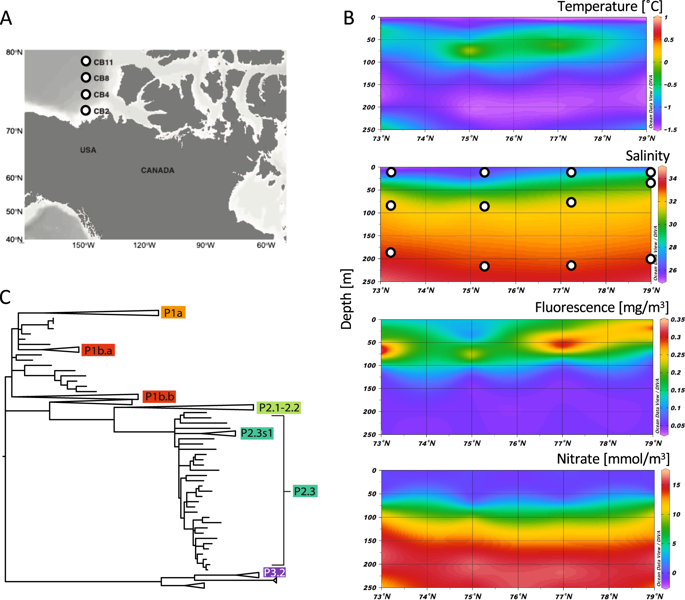Our official English website, www.x-mol.net, welcomes your
feedback! (Note: you will need to create a separate account there.)
Diversity and biogeography of SAR11 bacteria from the Arctic Ocean.
The ISME Journal ( IF 10.8 ) Pub Date : 2019-09-09 , DOI: 10.1038/s41396-019-0499-4
Susanne Kraemer 1 , Arthi Ramachandran 1 , David Colatriano 1 , Connie Lovejoy 2 , David A Walsh 1
The ISME Journal ( IF 10.8 ) Pub Date : 2019-09-09 , DOI: 10.1038/s41396-019-0499-4
Susanne Kraemer 1 , Arthi Ramachandran 1 , David Colatriano 1 , Connie Lovejoy 2 , David A Walsh 1
Affiliation

|
The Arctic Ocean is relatively isolated from other oceans and consists of strongly stratified water masses with distinct histories, nutrient, temperature, and salinity characteristics, therefore providing an optimal environment to investigate local adaptation. The globally distributed SAR11 bacterial group consists of multiple ecotypes that are associated with particular marine environments, yet relatively little is known about Arctic SAR11 diversity. Here, we examined SAR11 diversity using ITS analysis and metagenome-assembled genomes (MAGs). Arctic SAR11 assemblages were comprised of the S1a, S1b, S2, and S3 clades, and structured by water mass and depth. The fresher surface layer was dominated by an ecotype (S3-derived P3.2) previously associated with Arctic and brackish water. In contrast, deeper waters of Pacific origin were dominated by the P2.3 ecotype of the S2 clade, within which we identified a novel subdivision (P2.3s1) that was rare outside the Arctic Ocean. Arctic S2-derived SAR11 MAGs were restricted to high latitudes and included MAGs related to the recently defined S2b subclade, a finding consistent with bi-polar ecotypes and Arctic endemism. These results place the stratified Arctic Ocean into the SAR11 global biogeography and have identified SAR11 lineages for future investigation of adaptive evolution in the Arctic Ocean.
中文翻译:

北冰洋 SAR11 细菌的多样性和生物地理学。
北冰洋与其他海洋相对隔离,由具有独特历史、营养、温度和盐度特征的强烈分层水团组成,因此为研究局部适应提供了最佳环境。全球分布的 SAR11 细菌群由与特定海洋环境相关的多种生态型组成,但人们对北极 SAR11 多样性知之甚少。在这里,我们使用 ITS 分析和宏基因组组装基因组 (MAG) 检查了 SAR11 多样性。北极 SAR11 组合由 S1a、S1b、S2 和 S3 分支组成,并由水质量和深度构成。较新鲜的表层主要由先前与北极和咸水相关的生态型(S3 衍生的 P3.2)主导。相比之下,太平洋起源的更深水域以 S2 分支的 P2.3 生态型为主,我们在其中确定了一个在北冰洋以外罕见的新细分(P2.3s1)。北极 S2 衍生的 SAR11 MAG 仅限于高纬度地区,并包括与最近定义的 S2b 分支相关的 MAG,这一发现与双极生态类型和北极特有现象一致。这些结果将分层的北冰洋纳入 SAR11 全球生物地理学,并确定了 SAR11 谱系,用于未来研究北冰洋的适应性进化。
更新日期:2019-09-09
中文翻译:

北冰洋 SAR11 细菌的多样性和生物地理学。
北冰洋与其他海洋相对隔离,由具有独特历史、营养、温度和盐度特征的强烈分层水团组成,因此为研究局部适应提供了最佳环境。全球分布的 SAR11 细菌群由与特定海洋环境相关的多种生态型组成,但人们对北极 SAR11 多样性知之甚少。在这里,我们使用 ITS 分析和宏基因组组装基因组 (MAG) 检查了 SAR11 多样性。北极 SAR11 组合由 S1a、S1b、S2 和 S3 分支组成,并由水质量和深度构成。较新鲜的表层主要由先前与北极和咸水相关的生态型(S3 衍生的 P3.2)主导。相比之下,太平洋起源的更深水域以 S2 分支的 P2.3 生态型为主,我们在其中确定了一个在北冰洋以外罕见的新细分(P2.3s1)。北极 S2 衍生的 SAR11 MAG 仅限于高纬度地区,并包括与最近定义的 S2b 分支相关的 MAG,这一发现与双极生态类型和北极特有现象一致。这些结果将分层的北冰洋纳入 SAR11 全球生物地理学,并确定了 SAR11 谱系,用于未来研究北冰洋的适应性进化。































 京公网安备 11010802027423号
京公网安备 11010802027423号